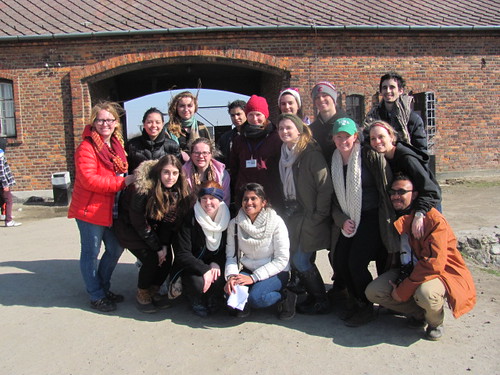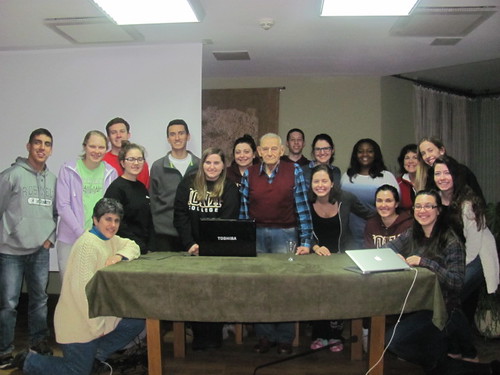Returning home from Poland and attempting to fully explain
my experience was tough. Sharing my new
knowledge about the Soah, Pope John Paul and Krakow wasn’t difficult. Sharing pictures with my loved ones was a bit
of a struggle, merely because I remember exactly how I felt when snapping them. Oddly enough the hardest part for me, was
answering the simple question of “How was Poland?” When someone first asked me this question, I
was dumbfounded. How does one fully explain
one week of their life that was life changing, eye opening, humbling and
incredible in a few sentences?
To be honest, I don’t have an
answer for my own question and still have some trouble answering it today. However,
I found when I set aside time to have a lengthy conversation with a family
member or good friend, I can fully explain my thoughts, feelings and
experience, so talking about Poland becomes easier. I am aware that everyone who asks about my
trip to Poland doesn’t actually want to hear every detail, so I describe my
experience to him or her as educational, unimaginable, bewildering and
mournful.
Flowers left on prisoner’s sleeping area
Even though our trip was only a short period of time, everyday
I find myself being reminded of Poland and/or the Soah. For example, a few weeks ago I was conversing
with a friend about my experience on this trip.
After sharing my pictures and telling him about some of the horrifying events
that occurred, he said “I don’t understand how people could let something like
this happen. Millions of people were
being killed, and no one even tried to stop it.” My heart dropped, but I knew what I had to
tell him. I told him all about righteous
gentiles and how it is so important not to judge other people’s actions,
especially when one doesn’t fully understand another’s circumstances. I also told him that some people wanted to
help the victims, but there were high risks involved, such as death, if they
were caught. I also reminded him that terrible
events occur today around world, but not everyone is sympathy or
proactive.
I think it is important to relate
my interaction to a reading we were assigned to read. It said “More or less eight to 10 million
people go to such exhibitions around the world today, they cry, they ask why
people didn’t react more at the time, why there were so few righteous, then
they go home, see genocide on television and don’t move a finger” (Kimmelman). This was a gentile reminder that it is so
easy to look back at our not so far away past and judge the actions of others.
It is difficult to grasp how a select group of humans
decided they had the right to create this camp and others like it, in order to
carryout a systemic genocide. Its tough to comprehend the horrific events and
my experience can be hard to talk about at times. Regardless, I believe it is vital for
everyone to study this time period and remember all of those affected by the
Soah, because most are gone, but all should be remembered.
WORK CITED
Kimmelman, Michael. "Auschwitz Shifts From
Memorializing to Teaching." The New York Times. The New York Times, 18
Feb. 2011. Web. 30 Apr. 2017.
 It has now been almost two months since our trip to Poland
had begun and ended. I’ve been trying to figure out how to put into words my
experience during this trip. Although it was overwhelming at times, I know it
was something not everyone gets to experience. Going into this trip I had a lot
of expectations and worries, like how would going to the concentration camps
make me feel? I have always been interested in the Holocaust since I read The Diary of Anne Frank when I was in
elementary school. I also have always had a desire to visit Auschwitz and
Birkenau for a few years now, so when I realized that Iona offered this course
it was something I was extremely interested in. Looking back on the day we left
for Oswiecim, Poland, I was super excited but also nervous. I had looked over
the itinerary for the week and started to prepare myself for what was to come. I’m
not a religious person, so after hearing about some of the tours I was a bit
anxious. Although I didn’t really know what to expect from this trip I’m extremely
grateful that I was given this opportunity, one that many people don’t have. The
whole week that we had spent In Poland was something that I could never fully
explain to someone who didn’t experience it first-hand. When we arrived back
from our trip, all everyone seemed to ask was… “How was visiting Auschwitz? Was
is scary? What was it like? How was Poland? What did you do?”. But, I couldn’t
give anyone a complete answer. I thought I would come back and be able to tell
everyone who asked just exactly what I did experience on this trip, but I couldn’t.
I still can’t find the words to explain what it was like to walk on the same
ground as millions of Jews did to their unknown death. It was eerily calm and
peaceful when we visited both camps and thinking back it’s such a weird thing to
say because of all the murder that happened at one time there. You heard the
birds chirping and you saw the grass growing where it used to not grow. I don’t
think that I would ever revisit Auschwitz-Birkenau, I feel as that it is a place
to visit once to give your respects. But, I too am now a witness and it’s my
job to make sure that this piece of history is never forgotten about.
It has now been almost two months since our trip to Poland
had begun and ended. I’ve been trying to figure out how to put into words my
experience during this trip. Although it was overwhelming at times, I know it
was something not everyone gets to experience. Going into this trip I had a lot
of expectations and worries, like how would going to the concentration camps
make me feel? I have always been interested in the Holocaust since I read The Diary of Anne Frank when I was in
elementary school. I also have always had a desire to visit Auschwitz and
Birkenau for a few years now, so when I realized that Iona offered this course
it was something I was extremely interested in. Looking back on the day we left
for Oswiecim, Poland, I was super excited but also nervous. I had looked over
the itinerary for the week and started to prepare myself for what was to come. I’m
not a religious person, so after hearing about some of the tours I was a bit
anxious. Although I didn’t really know what to expect from this trip I’m extremely
grateful that I was given this opportunity, one that many people don’t have. The
whole week that we had spent In Poland was something that I could never fully
explain to someone who didn’t experience it first-hand. When we arrived back
from our trip, all everyone seemed to ask was… “How was visiting Auschwitz? Was
is scary? What was it like? How was Poland? What did you do?”. But, I couldn’t
give anyone a complete answer. I thought I would come back and be able to tell
everyone who asked just exactly what I did experience on this trip, but I couldn’t.
I still can’t find the words to explain what it was like to walk on the same
ground as millions of Jews did to their unknown death. It was eerily calm and
peaceful when we visited both camps and thinking back it’s such a weird thing to
say because of all the murder that happened at one time there. You heard the
birds chirping and you saw the grass growing where it used to not grow. I don’t
think that I would ever revisit Auschwitz-Birkenau, I feel as that it is a place
to visit once to give your respects. But, I too am now a witness and it’s my
job to make sure that this piece of history is never forgotten about. 




























